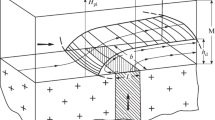Abstract
A new point of view describing processes of partial melting and development of gravitational instability in a thickening crust with increased thickness of the granite layer is suggested. Numeral experiments support the following main conclusions. The critical volume of partially melted material should be formed for the beginning of flotation in a gravitational field. Due to model estimations, the height of the melting area in the granite crust should be not less than 6–7 km. A mushroom-shaped form of the floating body was observed in all models regardless of the thermal source size (fixed or variable width): the high temperature channel (magma leader) and head body of the diapir are formed. The height of diapir floating depends on rheological features of the surrounding crust: 10 times increase in the yield strength (from 1 to 10 MPa) while temperature decrease confines the possible level of rising to a depth of 15–16 km. An elevation of about 750 m is formed in the day surface relief above the axis part of the diapir.
Similar content being viewed by others
References
S. N. Korobeynikov, V. V. Reverdatto, O. P. Polyansky, et al., Sib. Zhurn. Vychisl. Matem. 12(1), 71–90 (2009) [in Russian].
V. V. Reverdatto, V. N. Sharapov, and R. M. Slobodskoy, Contrib. Mineral. Petrol. 36, 195–206 (1972).
S. N. Korobeynikov, O. P. Polyansky, V. G. Sverdlova, et al., Dokl. Earth Sci. 421(5), 724–730 (2008) [Dokl. Akad. Nauk 420 (5), 654–658 (2008)].
A. V. Babichev, I. S. Novikov, O. P. Polyanskii, et al., Geol. Geofiz. 50(2), 137–151 (2009).
Marc User’s Manual, Vol. A: Theory and Users Information (MSC Software, Santa-Ana, 2005).
C. Annen and R. S. J. Sparks, Earth Planet. Sci. Lett. 203, 937–955 (2002).
M. W. Schmidt and S. Poli, Earth Planet. Sci. Lett. 163, 361–379 (1998).
M. R. Handy, Tectonophysics 163, 119–152 (1989).
T. V. Gerya and J.-P. Burg, Phys. Earth Planet. Inter. 160, 124–142 (2007).
J. C. Arkwright, E. H. Rutter, K. H. Brodie, et al., J. Geol. Soc. 165, 639–649 (2008).
B. Bos and Ch. J. Spiers, J. Geophys. Res. 107(B2), 1029 (2002).
D. Bittner and H. Schmeling, Geophys. J. Intern. 123, 59–70 (1995).
A. D. Nozhkin, O. M. Turkina, Yu. M. Petrov, et al., in Uranium and Thorium in Metamorphic Petrogenesis (Nauka, Novosibirsk, 1983) [in Russian].
A. D. Nozhkin, O. M. Turkina, E. V. Bibikova, et al., Geol. Geofiz. 40(9), 1305–1313 (1999).
V. A. Vernikovsky and A. E. Vernikovskaya, Geol. Geofiz. 47(1), 35–52 (2006).
Author information
Authors and Affiliations
Additional information
Original Russian Text © O.P. Polyansky, S.N. Korobeynikov, A.V. Babichev, V.V. Reverdatto, V.G. Sverdlova, 2009, published in Doklady Akademii Nauk, 2009, Vol. 429, No. 1, pp. 101–105.
Rights and permissions
About this article
Cite this article
Polyansky, O.P., Korobeynikov, S.N., Babichev, A.V. et al. Computer modeling of granite magma diapirism in the Earth’s crust. Dokl. Earth Sc. 429, 1380–1384 (2009). https://doi.org/10.1134/S1028334X09080315
Received:
Published:
Issue Date:
DOI: https://doi.org/10.1134/S1028334X09080315




